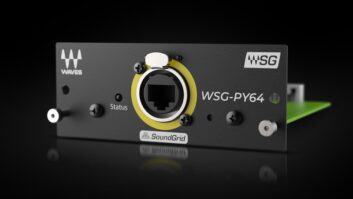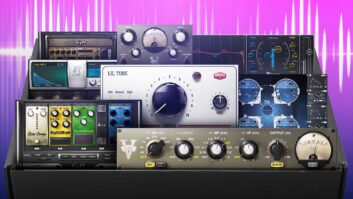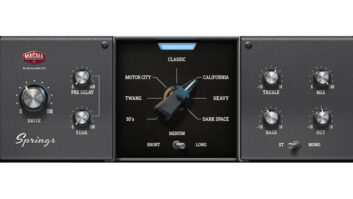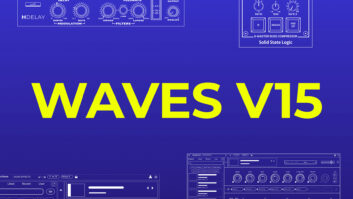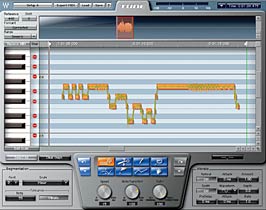
Waves Tune’s Edit window shows pitch blocks, and original and corrected pitch.
One of five plug-in processors in the new Waves Vocal Bundle (which also includes DeBreath, Renaissance DeEsser, Renaissance Channel Strip and Waves Doubler), Waves Tune corrects the pitch of monophonic sources, smooths note transitions, and allows for detecting and editing natural vibratos. It does all this while preserving formants, the groups of frequencies that characterize vowel sounds. Formants are extremely important for keeping pitch-shifted vocals sounding natural.
GETTING READY TO START
Waves Tune runs as a ReWire client on PCs under Windows XP and Macs running OS 10.3 and above. Hosts that support Waves Tune include Pro Tools TDM or LE (Versions 6.9 and 7), Cubase SX 3.1, Nuendo 3.1, Digital Performer 4.6 and Logic 7.1. Waves Tune’s large interface (via ReWire) lets you operate the host’s transport controls and set loop start/stop points any place from within the plug-in; there is no need to refer to another program or screen. I installed the Vocal Bundle into a Mac G5 Quad Core with 4.5 GB of RAM running Pro Tools 7.1cs4 on an HD3 PCIe system.
Before any correction can occur, Waves Tune must scan the audio file. Its memory is capable of holding up to 10 minutes of audio. The software has a latency of 3,072 samples at 44.1- and 48kHz, and 6,144 samples at 88.2- or 96kHz sample rates. As a workaround, I found it good practice to copy the track to be tuned, scan it and then offset to match the original. You could also rely on Waves Tune to report its latency to automatic delay compensation in the host program.
LOADED AND READY TO GO
In my first test, I put Waves Tune to work on a female singer who has extraordinary pitch control to see if I could improve her ability. Before I scanned, I set the four setup sections for optimal performance by choosing my reference pitch, formant correction on/off, frequency range and global pitch shift. Next, I used the Segmentation and Scale Selection to designate the song’s key and note scale. Then, I set the Note Tolerance. I found Waves Tune’s note pitch-change sensitivity control useful when tuning vocal melismas and portamento, where many separate note segment blocks are required to accurately track an elaborate vocal run or ad lib.
Lastly, if desired, the Vibrato button let me set the target note as the average pitch of the detected vibrato. This defaults to off, but — as with all of the previously mentioned parameters — you can make changes and apply them to any section(s) later after your initial scan. You can undo/redo any step in your pitch-correction session within a maximum of 32 steps.
WHAT YOU SEE
Waves Tune’s Edit window includes a scanned track overview waveform, a sharp/flat tuning gauge, plug-in automation, load/save settings and MIDI export. The Pitch Editor section shows a piano keyboard positioned vertically on the left side of the window to serve as a reference and to indicate the sung note and/or input received from a MIDI keyboard. The audio’s original pitch is shown as an orange waveform superimposed by the corrected pitch in green. While in play, these waveforms parade across the window with the currently sung vocal notes always in view.
Each note resides within a white note-segment block that aligns in a grid to the keys of the piano’s keyboard. Within these blocks, you can see just how sharp or flat each note is in relation to exact, perfect pitch. Vibrato is clearly visible. Waves Tune also tracks and corrects the pitch center of notes with heavy vibrato, while maintaining sound quality and the vibrato’s intensity and shape.
The Correction Parameters section has three controls: Speed, which determines how fast Waves Tune corrects pitch; Note Transition to adjust the correction speed from note block to note block; and Ratio, an overall correction-intensity control. I found that the default settings worked best when tuning my female singer.
For microscopic changes, there are eight graphical tools, including Note to drag single or multiple note blocks to different pitches; Trim for lengthening/shortening notes by grabbing and dragging a corner of any block; Zoom; and Slice, which splits up single notes into additional notes.
TUNING, 1-2-3
I found that certain notes sounded better when not strictly tuned, particularly in blues/rock music. Fine-tuning the Correction controls provided me with everything from smooth, natural transitions to jagged and quantized robotic moves.
With my female singer, I restructured the chorus melody by simply dragging a note block to the desired pitch. Lengthening notes works great for small increases, and I added vibrato to a note or two. I also tried removing vibrato for an interesting effect that leaves only the amplitude component of natural vibrato.
Tuning vocals can be time-intensive, meticulous work, but I found that Waves Tune elevates the entire process with its elegant operation and superior sound quality. Price: $600, stand-alone; $1,000, part of Vocal Bundle.
Waves, 865/909-9200, www.waves.com.
Barry Rudolph is an L.A.-based recording engineer. Contact him via his Website:
www.barryrudolph.com.

